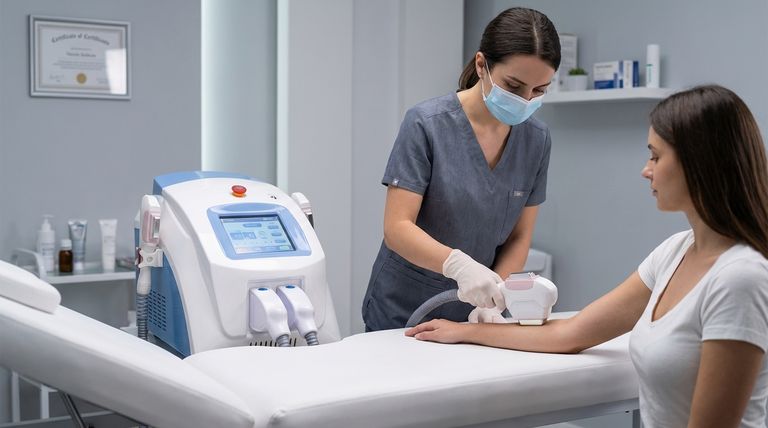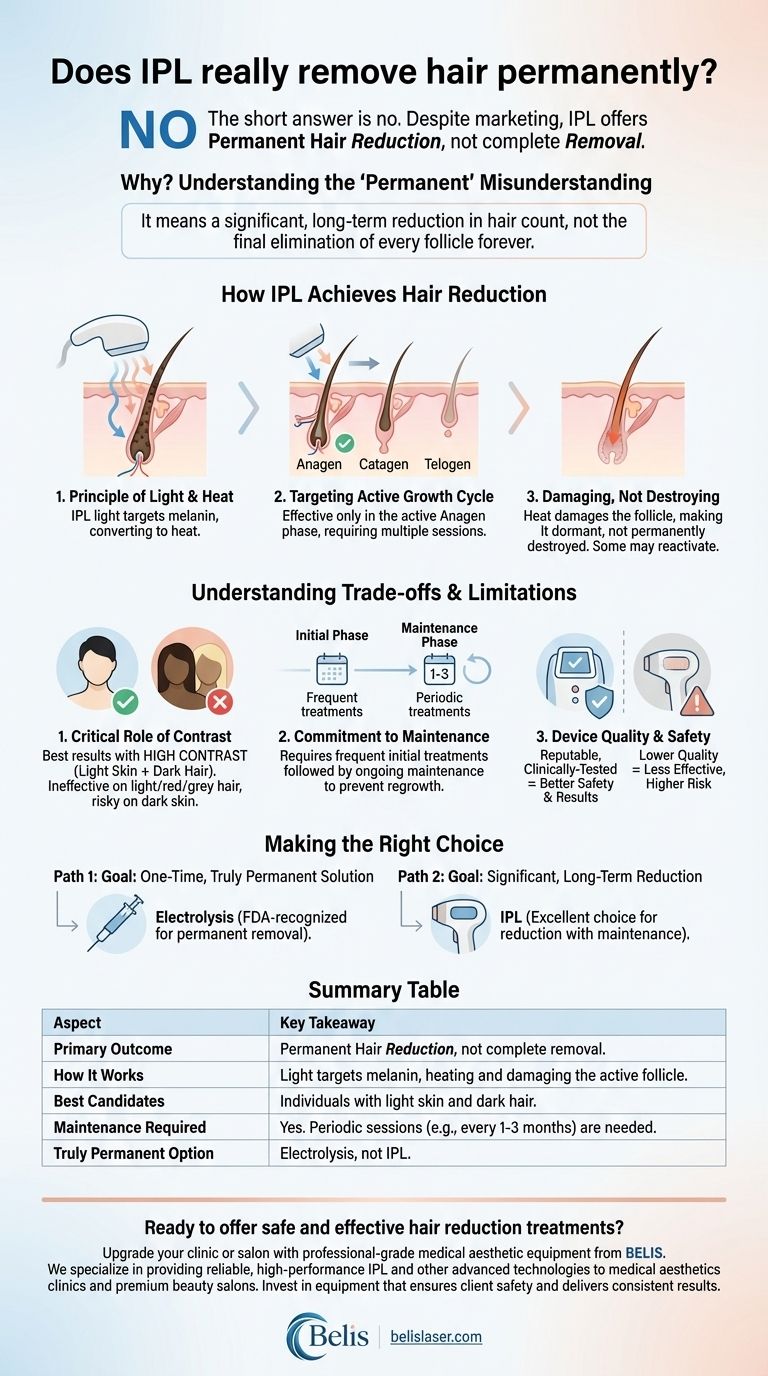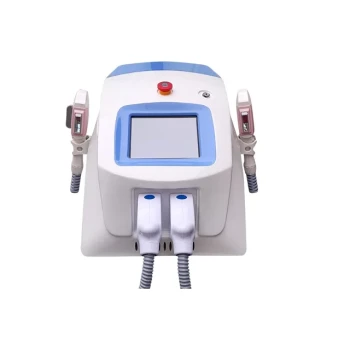The short answer is no. Despite common marketing claims, Intense Pulsed Light (IPL) does not result in the permanent removal of all hair. Instead, it offers permanent hair reduction, a critical distinction for setting realistic expectations. The treatment significantly lessens hair growth, but periodic maintenance is required to sustain the results.
The core misunderstanding lies in the term "permanent." In the context of light-based treatments, it refers to a significant and stable reduction in hair count over the long term, not a complete and final elimination of every hair follicle forever.

How IPL Achieves Hair Reduction
IPL technology works by targeting the pigment (melanin) within the hair. This process is a foundational concept in understanding its effects and limitations.
The Principle of Light and Heat
IPL devices emit a broad spectrum of light, which travels through the skin. This light energy is absorbed by the dark melanin in the hair shaft.
Upon absorption, the light energy converts into heat. This heat then travels down the hair to the follicle, damaging key structures responsible for hair growth.
Targeting the Active Growth Cycle
Hair grows in cycles, and IPL is only effective when the hair is in its active growth phase (anagen). During this phase, the hair is physically connected to the follicle.
Because only a fraction of your hair is in the anagen phase at any given time, multiple sessions are required. Treatments are spaced several weeks apart to catch new hairs as they enter this active growth stage.
Damaging, Not Destroying, the Follicle
The heat from an IPL treatment aims to put the hair follicle into a state of dormancy. It doesn't permanently destroy it.
Over time, some of these dormant follicles may reactivate due to hormonal changes or other bodily factors, resulting in new hair growth. This is why ongoing maintenance is a non-negotiable part of any IPL regimen.
Understanding the Trade-offs and Limitations
While effective for reduction, IPL is not a universal solution. Its effectiveness is highly dependent on specific biological factors and a commitment to a consistent treatment schedule.
The Critical Role of Contrast
IPL works best when there is a high contrast between your skin tone and hair color—specifically, light skin and dark hair. The device needs to "see" the dark hair against a light background to target it effectively.
This technology is largely ineffective on very light blonde, red, or grey hair, as there is not enough melanin to absorb the light. Furthermore, using IPL on dark skin tones is dangerous, as the device may target the melanin in the skin itself, leading to burns or discoloration.
The Commitment to Maintenance
Achieving significant hair reduction requires an initial phase of frequent treatments (e.g., once a week for several weeks).
After this initial period, you must transition to a maintenance schedule. Most users find they need to perform a treatment once every one to three months to keep the area smooth and prevent regrowth from the dormant follicles.
Device Quality and Safety
The market is saturated with IPL devices, but their quality varies dramatically. Reputable, clinically-tested devices from established brands offer better safety features and more consistent energy output.
Lower-quality, unregulated devices may be less effective or pose a greater risk of adverse side effects. The power and precision of the device directly impact the quality of the hair reduction you can achieve.
Making the Right Choice for Your Goal
Your decision to use IPL should be based on a clear understanding of what it can and cannot do.
- If your primary focus is a one-time, truly permanent solution: IPL is not the right technology; only electrolysis is recognized by the FDA for permanent hair removal.
- If your primary focus is significant, long-term hair reduction with the convenience of at-home treatment: IPL is an excellent choice, provided you have a suitable skin/hair type and are committed to the required maintenance.
Ultimately, approaching IPL with the correct knowledge empowers you to manage your expectations and achieve the best possible results.
Summary Table:
| Aspect | Key Takeaway |
|---|---|
| Primary Outcome | Permanent Hair Reduction, not complete removal. |
| How It Works | Light targets melanin, heating and damaging the active follicle. |
| Best Candidates | Individuals with light skin and dark hair. |
| Maintenance Required | Yes. Periodic sessions (e.g., every 1-3 months) are needed. |
| Truly Permanent Option | Electrolysis, not IPL. |
Ready to offer safe and effective hair reduction treatments?
Upgrade your clinic or salon with professional-grade medical aesthetic equipment from BELIS. We specialize in providing reliable, high-performance IPL and other advanced technologies to medical aesthetics clinics and premium beauty salons.
Invest in equipment that ensures client safety, delivers consistent results, and enhances your service offerings.
Contact BELIS today to explore our solutions and elevate your practice.
Visual Guide

Related Products
- IPL SHR Hair Removal Machine for Permanent Hair Removal
- Clinic Use IPL and SHR Hair Removal Machine with Nd Yag Laser Tattoo Removal
- Clinic Use IPL SHR ND YAG Laser Hair Removal RF Skin Tightening Machine
- IPL SHR+Radio frecuency machine
- Diode Tri Laser Hair Removal Machine for Clinic Use
People Also Ask
- What is intense pulsed light good for? A Versatile Solution for Sun Spots, Redness, and Hair
- What should I look for in an IPL machine? Key Features for Effective Hair Removal
- Does IPL hair removal actually work? Achieve Long-Term Hair Reduction
- Does IPL hair removal really work? Unlock Long-Term Hair Reduction with Science
- Can you use hair removal device on private parts? A Guide to Safe Bikini Area IPL



















